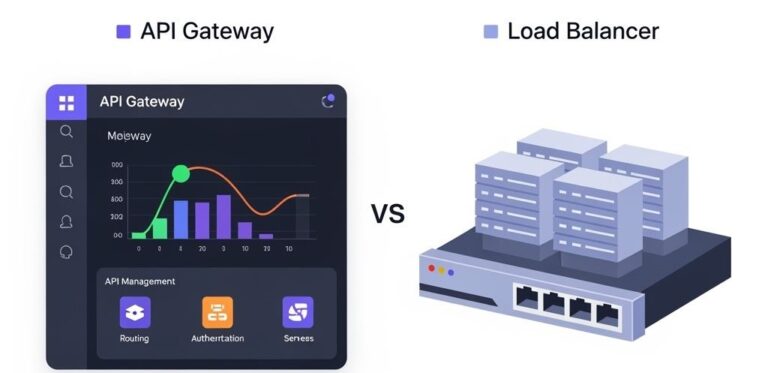
API Gateway vs Load Balancer: What’s the Difference & When to Use Each (With Real Examples)

When deploying web applications, two critical components often come up: API Gateways and Load Balancers. While both manage traffic, they solve different problems.
Choosing the wrong one can lead to performance issues, security flaws, and higher costs.
In this guide, we explain the differences in simple terms, supported by real-world examples, so you can make the right choice for your system.
1. What is a Load Balancer?
Definition:
A Load Balancer distributes incoming traffic across multiple servers to prevent any one server from being overwhelmed.
How It Works:
Analogy:
Imagine a pizza delivery kitchen with multiple chefs. The manager (load balancer) assigns orders to different chefs. If one chef is unavailable, the manager reroutes the orders.
Use Cases:
-
✔ Scaling apps to handle more users
-
✔ Ensuring uptime and availability
Types of Load Balancers:
-
Application Load Balancer (ALB) – HTTP/HTTPS traffic
-
Network Load Balancer (NLB) – TCP/UDP traffic
-
Classic Load Balancer (CLB) – Legacy option
Real-World Example:
When you access Facebook, a load balancer decides which server processes your request.
2. What is an API Gateway?
Definition:
An API Gateway acts as a traffic controller for APIs—routing, authenticating, and managing requests between clients and backend services.
How It Works:
Analogy:
Like a hotel concierge, an API Gateway accepts your request and sends it to the right service, checks your identity, and may modify the response.
Use Cases:
-
✔ Microservices management
-
✔ Authentication (OAuth, JWT)
-
✔ Request/response transformation (JSON ↔ XML)
Real-World Example:
When you use Uber, your app’s request (e.g., “Find a ride”) goes to an API Gateway, which routes it to the right internal service like pricing or maps.
3. Key Differences: API Gateway vs Load Balancer
| Feature | Load Balancer | API Gateway |
|---|---|---|
| Role | Distributes server traffic | Manages & routes API requests |
| OSI Layer | Layer 4 or 7 | Layer 7 |
| Protocol Support | HTTP, TCP, UDP | HTTP, HTTPS, WebSocket |
| Security | Basic (SSL) | Advanced (Auth, Rate Limits) |
| Common Use | Scalability | Microservices Management |
| Tools | AWS ALB, Nginx, HAProxy | AWS API Gateway, Kong, Apigee |
4. When to Use Each?
Use a Load Balancer When:
-
You need high availability and fault tolerance
-
Your app has multiple backend servers
-
You want to distribute traffic evenly
Use an API Gateway When:
-
You use microservices with different APIs
-
You need security features like JWT/OAuth
-
You want to log, throttle, or transform requests
5. Can They Work Together?
Yes! Many modern architectures use both for optimal efficiency.
Example – E-Commerce App:
-
API Gateway: Handles login, cart, and payment routing.
-
Load Balancer: Balances traffic among checkout servers.
6. Common Mistakes to Avoid
❌ Using a Load Balancer as an API Gateway – lacks API-level controls
❌ Using an API Gateway for raw TCP/UDP – not designed for low-level traffic
❌ Not scaling both – bottlenecks can still happen
7. Final Verdict: Which One Do You Need?
| Scenario | Best Choice |
|---|---|
| Scaling web traffic | Load Balancer |
| Managing multiple APIs | API Gateway |
| Need authentication or rate limiting | API Gateway |
| Basic server distribution | Load Balancer |
💡 Key Takeaway:
-
Load Balancer = Traffic Cop → directs traffic evenly to servers.
-
API Gateway = Smart Router → manages, filters, and transforms API calls.
For robust, scalable systems, use both together!




